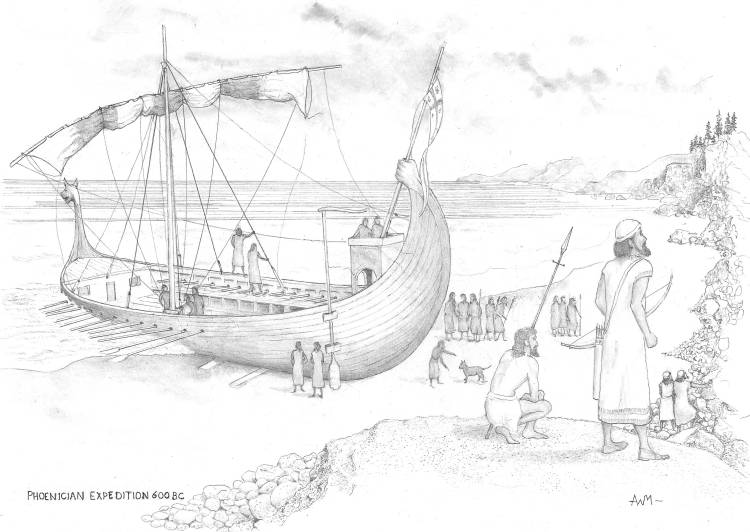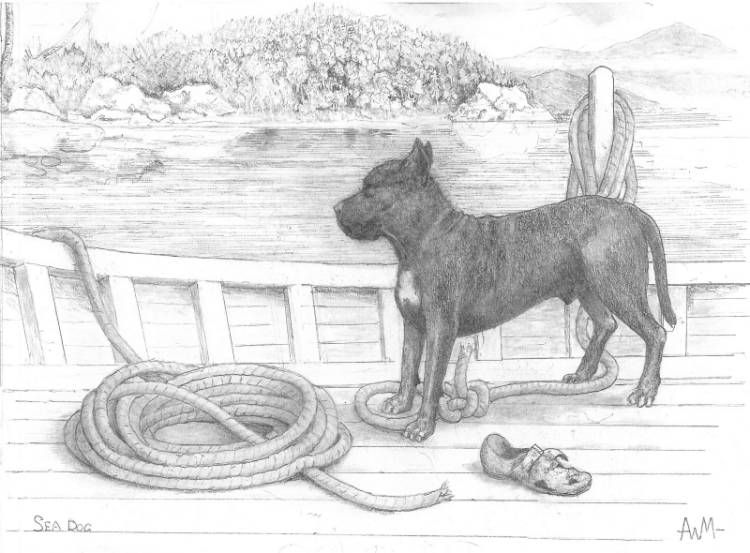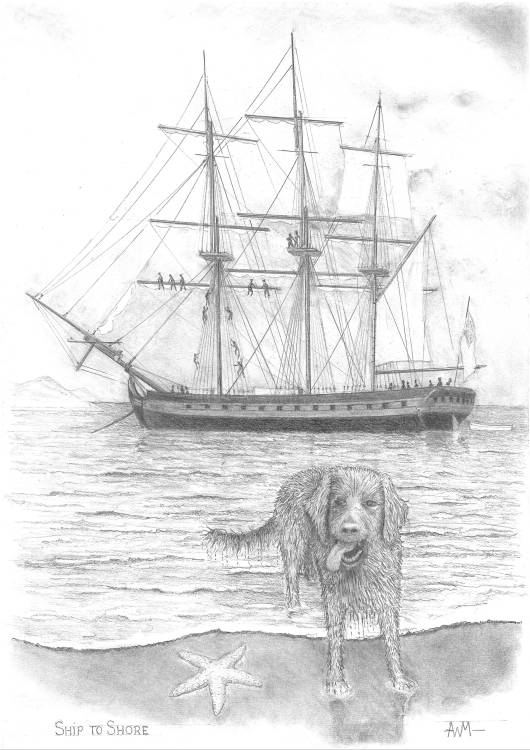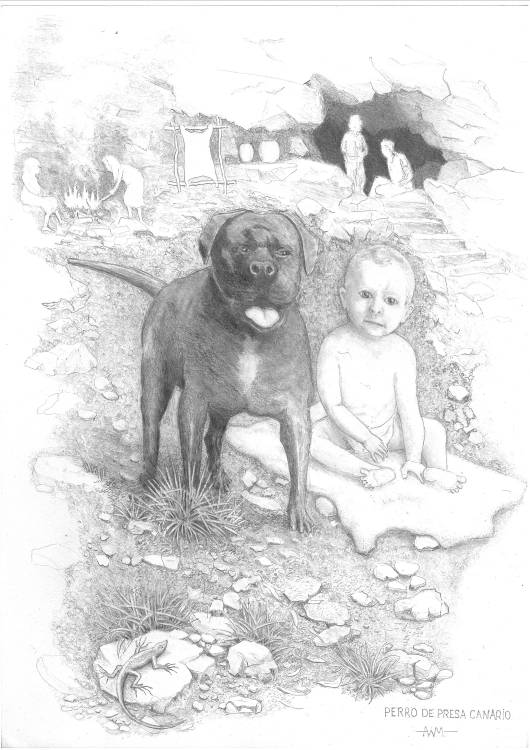What are we looking at here?
We are looking at the Guanche people
left behind in a Neolithic Stone age culture
where they dallied in ignorance while the rest
of the world moved on until their total defeat by
the forces of Spain at the end of the 15th century.
They were cave-dwellers, ruled by kings
and princes and bound on their seven islands
by rigorous judicial systems that stressed the
obligation of honour and respect towards women.
They lived by herding and by agriculture. Their animals
were goats, sheep, pigs and dogs, they used stone mills
to grind wheat, barley and beans into flour. Figs and dates
were also part of their diet.
Their kitchen implements were made of wood, sewing needles
and bodkins of fishbone; pottery was formed by hand without
the potter's wheel. Containers were made of leather, goat or
sheepskin. Clothes were also made of leather and rushes
divided into strips and plaited.
Weapons were made of wood and stone, knives chipped from
obsidian, spears of wood their tips hardened by scorching,
and clubs of round stones plaited with leather handles.
The Guanches were believed to be of a different race from
the natives of North West Africa, they were a white race -
neither Arab nor Berber but with some affiliations to the
Berbers with only the forbearance of myth and mysticism
to sustain this belief.
Their language is lost though it was said to resemble the
language of the Berbers. They had songs and dances
not dissimilar in performance and sentiment to those of
other traditional communities.
We can draw no helpful clues from the few words which remain of the Guanche language, but we can study their Neolithic society. Alleged racial similarities have pinned their origin to Phoenecian, Carthaginian, Greek, Egyptian, Celtic and other widely dispersed sources, even Atlantean in support of the Platonic legend of Atlantis, and from these mysteries has arisen an impractical proposition, for how is it possible that this Neolithic Guanche society was totally derelict of all the skills of their more sophisticated forbears? Neither the science of shipbuilding, nor the potter's wheel or even archery arose amongst these strangely ignorant people. And how did their society persist as a recognisable whole, having survived invasions from seafarers of more advanced culture arriving at their shores needing drinking water and fresh meat and the taking of slaves, yet left the islanders relatively untrammeled by diseases brought in from outside... Hmmm!

So let us assume that 'invasions' in the earliest times were vessels of the Phoenician era, a seagoing people who established numerous colonial cities along the Mediterranean and north-west African coast from 600BC to 150BC. Their battles on more or less equal terms with the emerging Roman Republic would suggest they were no mean adversaries. Yet, with the Canary Islands within their reach, how come they did not reduce these unsophisticated native inhabitants to abject defeat? We imagine Phoenician vessels with raised oars and about to drop anchor being faced with a solid wall of Guanche defenders with spears held aloft, roaring defiance from the shore supported by huge Canarian dogs with bared teeth. Even the most courageous Phoenician captain with his weakened crew desperate for replenishment would up anchor and sail away, his reports to the admiral most likely stressing the need for invasion in strength of these savage shores. But, hang about! Other visitors, Arabs from north-west Africa, pirates and privateers of many nations, came ashore at the Canary Islands in need of drinking water and timber for ship repairs and the stealing of children for slavery. Some visitors were welcome, some were not. How come?
By gifts: Gifts to uphold the cordial tone of peace and friendship; the gift of a Guanche maiden to a Spanish conquistador; the gift of a shining metal sword to a Mencey (King) of a local Guanche tribe who knew only wood and flint; and maybe a bronze parade mask, a gift from Juba II, a vassal king of Mauritania under Rome. Such untypical gifts were occasionally found as grave goods.

But where did the dogs come from? The name was first applied to Gran Canario and referred to a species of whiskered monk seal that used to pop up and take a gander at passing ships: they were present in the time of The Ancients and were called "sea dogs" and we think they were slaughtered to extinction by seafarers desperate for meat. Eventually they were replaced by guard dogs escaping from visiting ships which, in the fullness of time, could be seen running in packs along the shoreline barking at new arrivals. Throughout the passing centuries and whilstever ships relied on wind and weather there was often a need to replenish stores and water en route.

Drawing close to the canine mind I picture the sea dog, desperate for a lap of sweet water and a bite of fresh meat, putting two and two together. Concluding that his people have gone ashore to find food and water he would not hesitate to do likewise where, with luck and cunning, the proper dog may find not only water but tasty rabbits to test his speed and agility. Whatever, it gives us a notion about the origins of the Guanche people who were not creatures of lurking mystique hidden in the mists of time but, like the dogs that swam ashore, merely mongrel strays from civilized distant lands seeking freedom from the hardships of sea-life. Islas Canarios = Islands of Dogs. Right! But we know nothing about dogs. There is now a club for Canarian dogs, a breed that has emerged from this hotch potch of escaping mongrels passed down through the centuries. So, where can I read up about Canarian Dogs?
"Bernardo," Lizzie suggests. "He'd just love a trip to the Uni to find a book. He can translate for your deceptably simple mind."
"Sweet mouse, let's leave my deceptably simple mind out of this. I have enough problems with English. Just get Bernardo."
"Just thought, dear heart, there's no such word as deceptably."
"Sweet lady, I could not disagree with you less!"
Whatever, to our mind it seems the most obvious solution is that both dogs and people arrived at these savage shores seeking asylum. Only the forbearance of myth and mystery, stories of giants and hideous unknown creatures, kept the mystery alive and the islands secure as places of refuge. So how about that as a starting point!

Mimi welcomes Manfred's outstretched hand with a kiss. With Bernardo she is rather more circumspect. The great dog book smells of DOG, probably due to a previous dog-owning borrower. There are a few page markers in place and it is clear that Bernardo has already done some homework.
Yes, but how did the horse get into this? Well it was Manfred. It suddenly came to me that Manfred is a geologist, of a similar ilk to Peter. And how did we get Peter? Birds. Birding drew us together, so why am I spending time with a German geologist whose only interest in birds is the sort you see on shelves in supermarkets? We just don't know with Manfred. Must look into it later... No, they are both pipe-smokers. Is that it? Can't be, there's no link. Well, they've met, obviously, but they don't actually know each other.
Atlantis? I put it to him: Our sweet and fragrant Guanches could have arrived here from Atlantis? Bollocks! he replied - so perfectly expressed his English sounded strange - the Atlanteans are alleged to have invented the stirrup and taken it to Numidia and the Numidian cavalry were predominant in the Roman army and were granted citizenship when they retired; and could an island nation like Atlantis devoted to science lose all its knowledge when it moved to the seven islands? Not so bloody likely! So, if these seven islands are supposed to be the last remains of Atlantis along with the Azores and Madeira, where's the evidence?. No seabed evidence has been found, though it is possible that seafloor drift may have hidden any obvious signs. Neither is there any human signature - except maybe the stirrup.
Bernardo enjoys a British pint so we have some beer in. Manfred prefers light German wines but please don't insult him with Liebfraumilch. We don't get Harold who is at the British Library with Claudia similarly engaged and away from home, Petalmost and Berenca have gone figging with Joan. So the female side is vacant... Fig and Rhubarb pie... Hmm! So all we have is a German intellectual, a Spanish banker and an ill-favoured British sceptic whose knowledge of dogs can be written on the back of a picture postcard.

"I shall begin," says Bernardo. "This is the History and Standard of the Presa Canario. Their remains are sometimes found with the remains of their masters."
The Canary Islands now has a club for its own special breed of dog known as the Club Español del Presa Canario. One ancient breed with a disposition for herding cattle, the Perro de Bardino Majorero, believed to have originated in Fuertoventura, is a major contributor. Many existing Spanish breeds have also joined in the development of the Preso Canario: the Bull Terrier, the Pit Bull Terrier, the Dogue de Bordeaux, the Spanish Alano, the Doberman and of course the Rottweiler bred from the Mollosus of ancient Rome and the local Rottweil terrier. During their march across Germany the Romans, keeping their army well supplied with beef, built a fort at Rottweil, whence the infamous Rottweiler dog sprang forth.
The complexity of the task is drawn out in numerous books on the genetic inheritance of Canarian dogs from the earliest documentation of the breed before the conquest by Spain in the early 15th century especially the Presa Español in its many varieties and the Spanish Bulldog (Alano). Eventually the Island dogs developed into a completely differentiated breed due to the influence of the Spanish breeds. By the 18th century English colonists brought their Bandogges and Tiedogges (Bulldogs and Mastiffs) and began crossbreeding with the then existent Perro de Presa. To what extent did these introduced breeds contribute genetically to the Presa Canario is unknown.
Reconstruction of the nearly extinct Presa Canario began in the early 1970's when strong Presas that were rustic, massive, vigorous and functional with acute watchdog instincts, strong temperament, calm yet confident and extremely territorial with unlimited courage and, when defending their territory, able to withstand harsh injury without surrendering their position.
Is there nothing that will convince me that the charmingly fluffy Pekinese is to be patted, left in charge of an infant, allowed to retrieve balls and sticks, and kept around as a member of the family?
Nope! If I am kind to dogs all I ask is that they be kind to me.
From me it requires a simple act of faith, something that needs to be booted and belted into place, for it won't get there of its own accord - not with me it won't!
Now we sit up straight and pay attention. Here is a Brief Historical Summary: the Mollasus dog native to the islands of Tenerife and Gran Canaria in the Canarian Archipelago has emerged as a result of crosses between Majorero, a pre-Hispanic cattle dog originating from these islands and the Mollasus dog brought to these islands from the Peninsula. This Presa Canario breed is known for its great loyalty to its human family, its distrust of strangers and its nobility of temperament. It has never been known to stray and is a superior guardian of its family.
Bernardo closes the book, looks around, "And all from the European Wolf."
We're so glad it's a brief summary. Smiling helps, the right kind of smiling. We can't always tell the right kind, though we think dogs can - the smile that's met with a growl rather than the one that's met with a wag. Dogs wag their tails whereas your actual wolf wouldn't be found dead...! Or would it? Does a wolf wag its tail?
Nope!
Are we sure?
Nope!
And how on earth can we discover if the wolf actually wags its tail? To my limited knowledge nothing has been written. I mean, what pleases a wolf sufficiently to bring forth a wag? A dog will carry a basket of shopping wagging its tail like fury; in expectation of 'walkies' a dog will sit sweeping the floor with its tail. Fancy, all these differing classes of dog merging into one breed just for the Canary Islands? Or maybe this is not the way breeding works.
We would think breeding is more secure with horses where mating is usually under human control, but dogs and people are not, they do it everywhere. Primitive tribes hid their women and children from invaders. And there was that snorting incident before Christmas, a couple of kids doing it in a car park totally unaware that they could be seen from above. Julio would have sorted it with a bucket of water but he wasn't around just then, only Mr and Mrs Simcock, a couple we know well, not pious but morally upright and guardians of forests, staying in G 4D and filling our conversation with self-sustaining Canarian pine trees that can grow on bare rock - whilst trying to keep her away from the balcony's edge...
"Interesting stuff, but I'm off," says Manfred. "I have work to do."
This is not really the time for recollection for the girls are back and Manfred is offered a handful of figs on his way out - but time back there was the almost divine presence of Aunt Nellie Moore's 'Robin' who, wagging his tail like mad, wouldn't leave me until he got his piece of dog choc. It was just the food. He ended his days quietly. "Just trotted off," said Aunt Nellie, soothingly; and many years later when the small boy had grown up and away and recollects a somewhat distraught lady in 'The Hop Pole' at Beeston, sobbing with rage; faces were turning even from Myfords factory opposite. Her dog had been ordered to be put down "He was only playing," she screamed over the comforting voices surrounding her; but for the sheer size of an Alsation compared with a small boy the dog could have been playing with a doll. Without a higher brain, the domesticated dog is still basically a hunting animal and to my mind cannot be trusted. In my younger days there used to be dog licences. They cost seven shillings and sixpence.
Some voices on the other end of this argument are stressing the need for proper training of animals. I understand that dogs can be trained relatively easily and they are loyal to their people. It's all got to do with selective breeding for social control and obedience. And we all know that animals can and will return to the wild, not just dogs but truculent dolphins that bite, and killer whales that murder their trainers - but we don't hear much about that stuff; we prefer the sentiment that sticks like glue, I have one that came from our Home Help Organiser, about a dearly loved man who, despite his walking frame, refused to shelter behind old age and resolutely took his dog for a walk every morning and evening. One morning his home help found him dead. The family took charge of the dog which refused to eat and five days later it too died. From the home help service sorrow between the man and his dog seemed equally shared for the otherwise healthy dog died of a broken heart. Broken heart, my arse! It was probably old like its master.
Holding emotion at bay is not the attitude I prefer, but it is the one I trust. Somewhere between me and the animal lover there lies a balanced view, it is called Critical Thinking.
And I'm not very good at that either!
And I've often wondered why Manfred speaks such excellent Spanish; such an observation entirely out of place in a bit of serious research merely illustrates the grasshopper mind of a true peasant.
